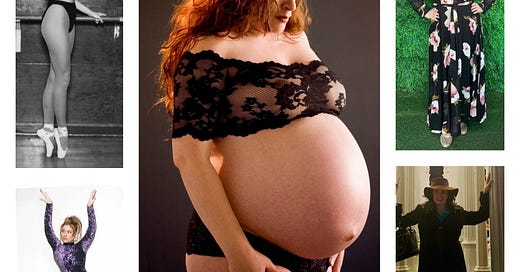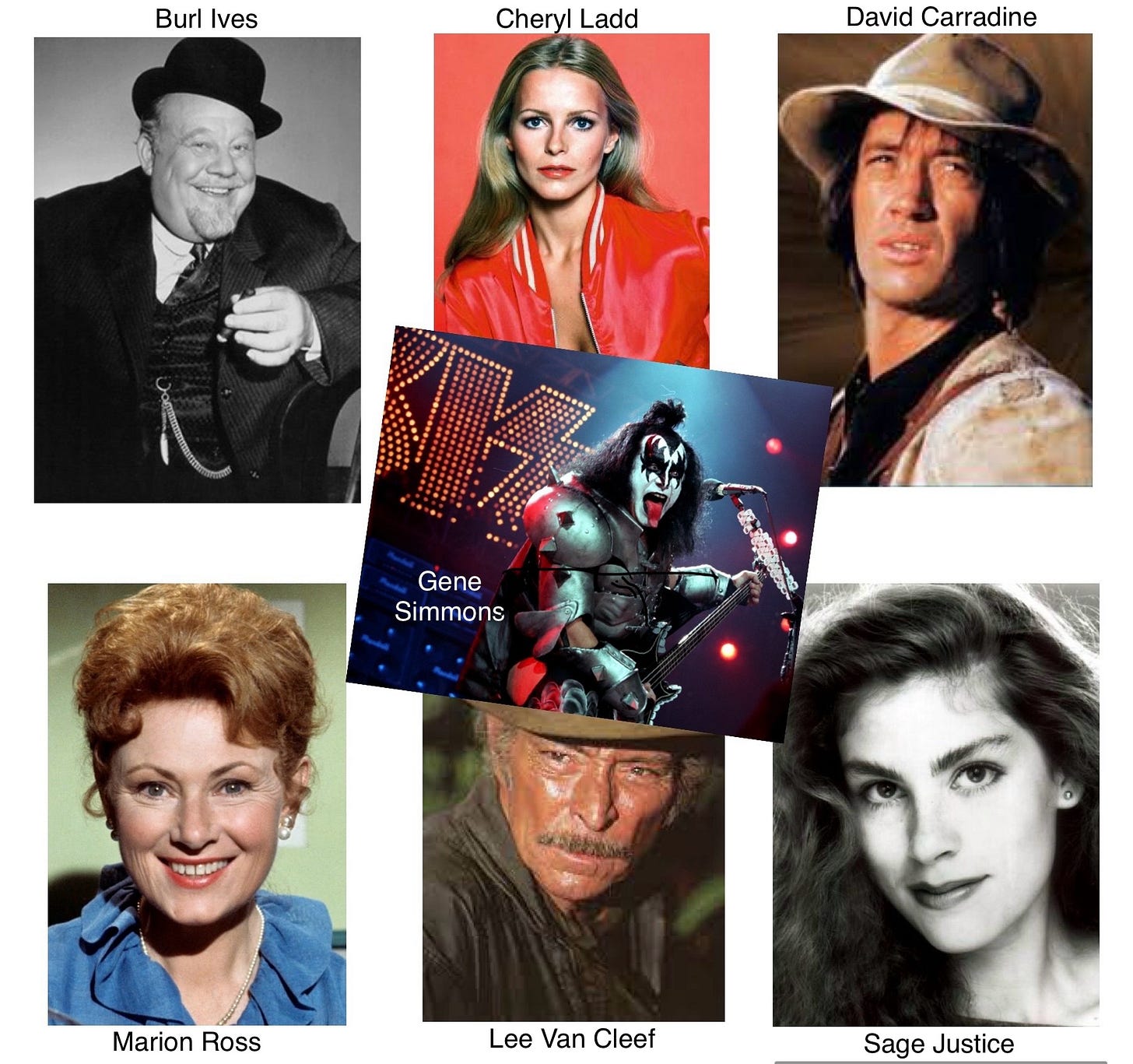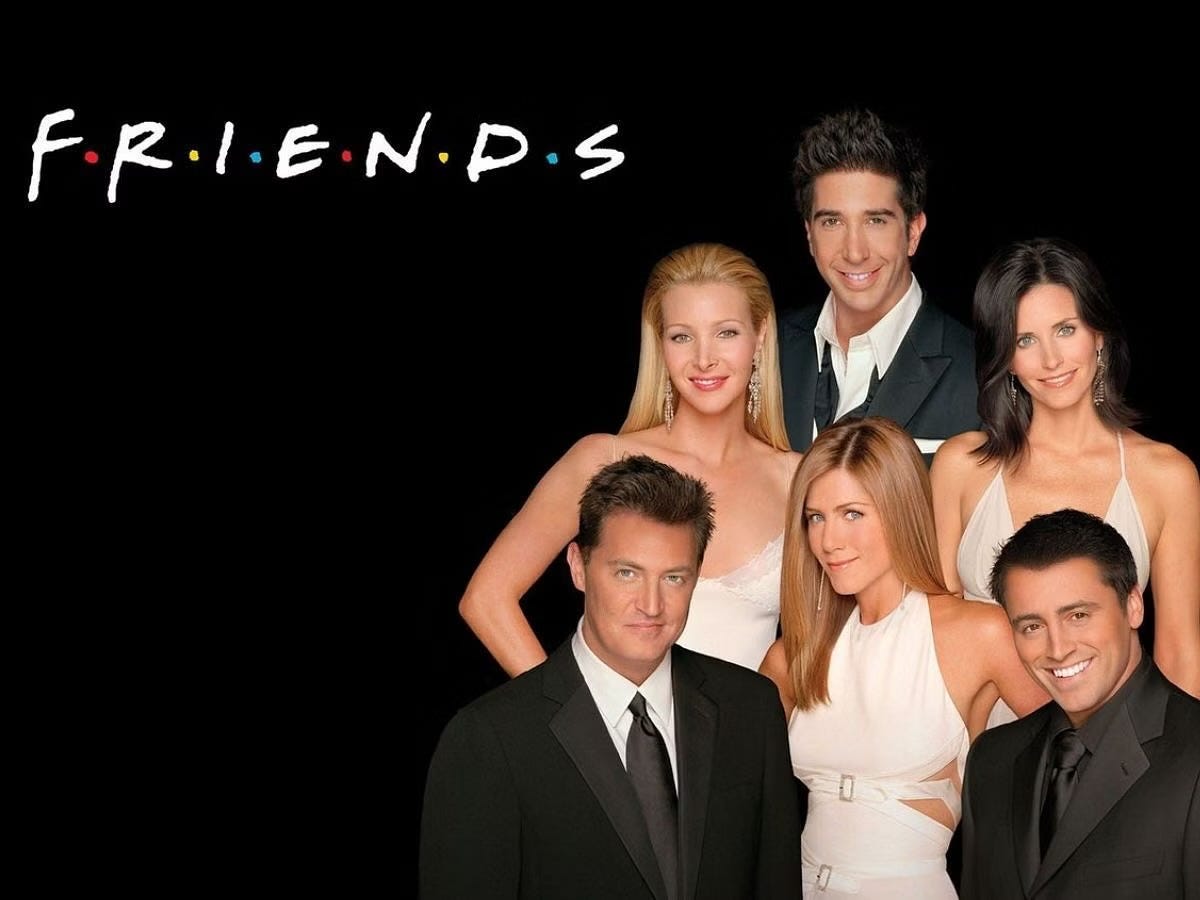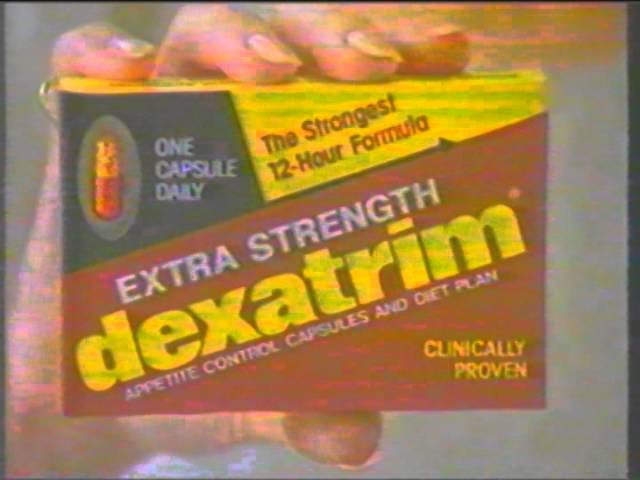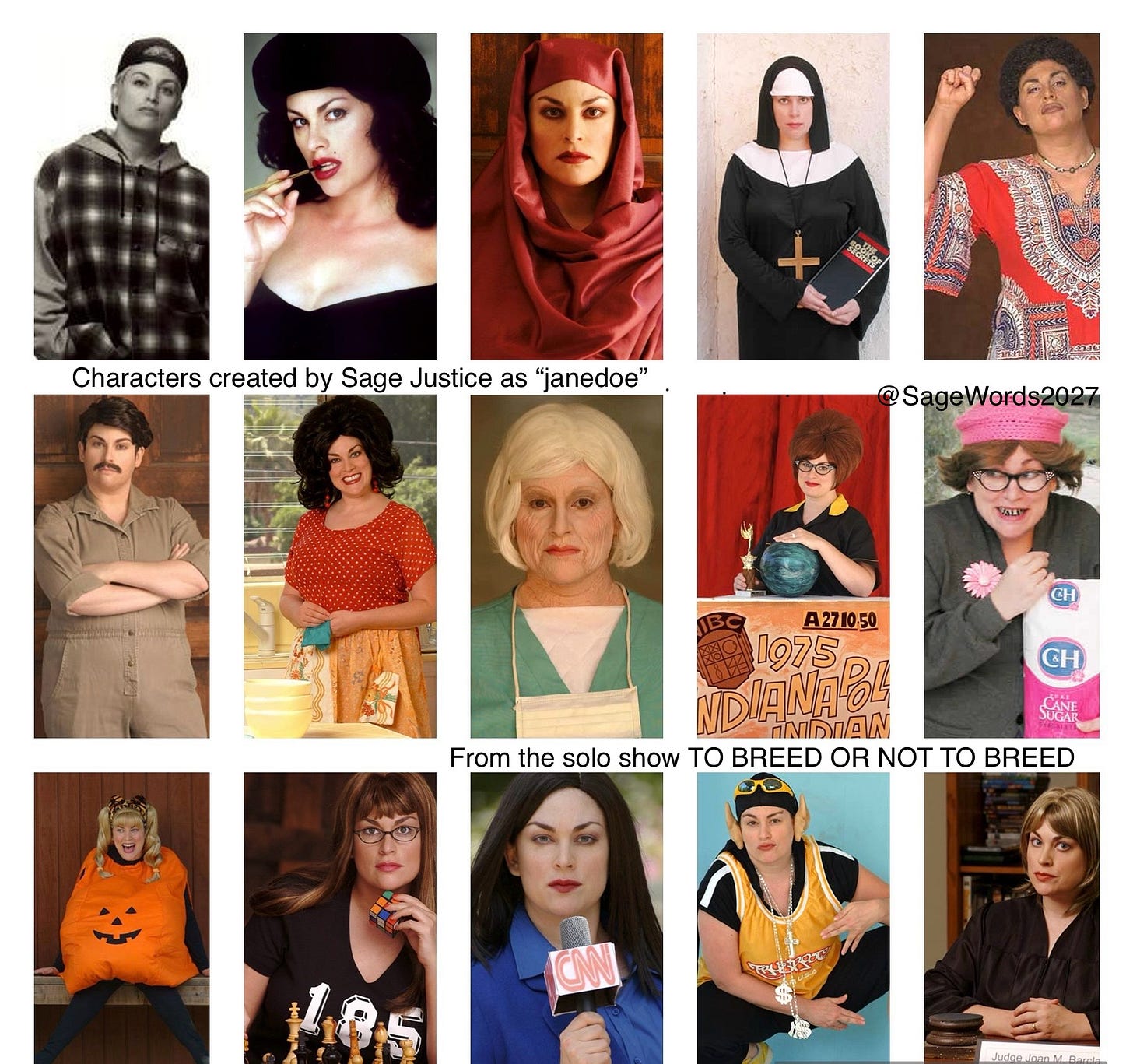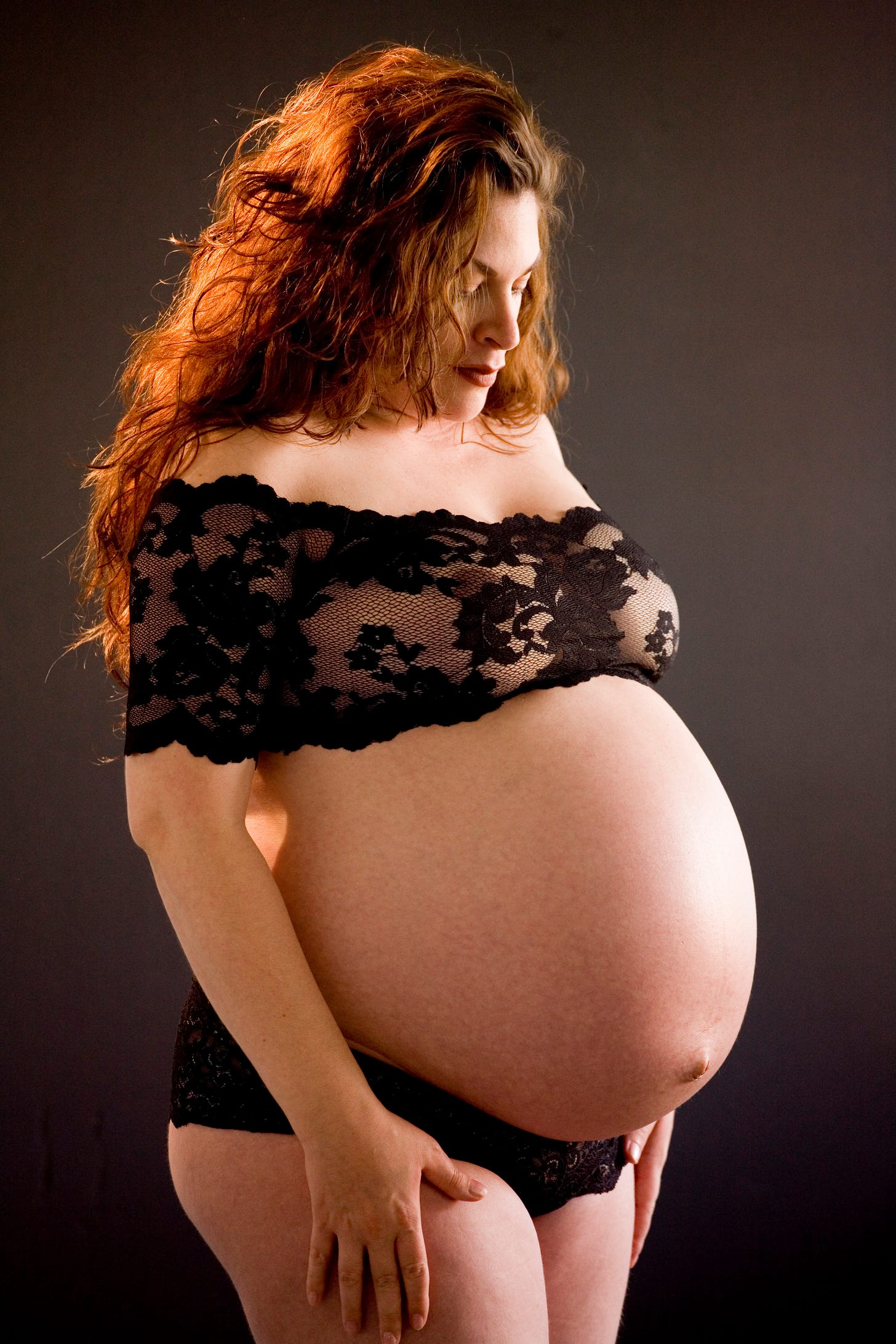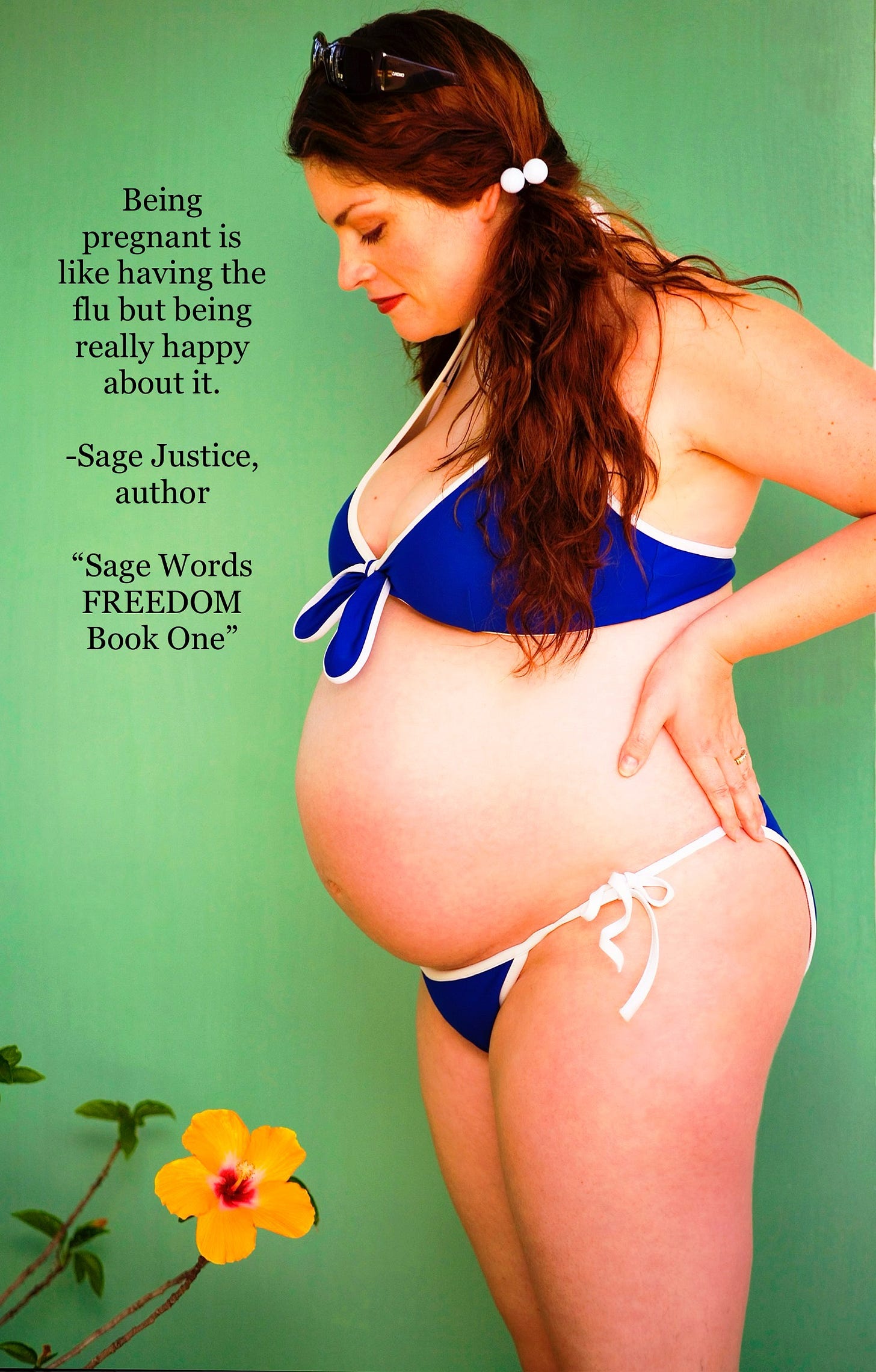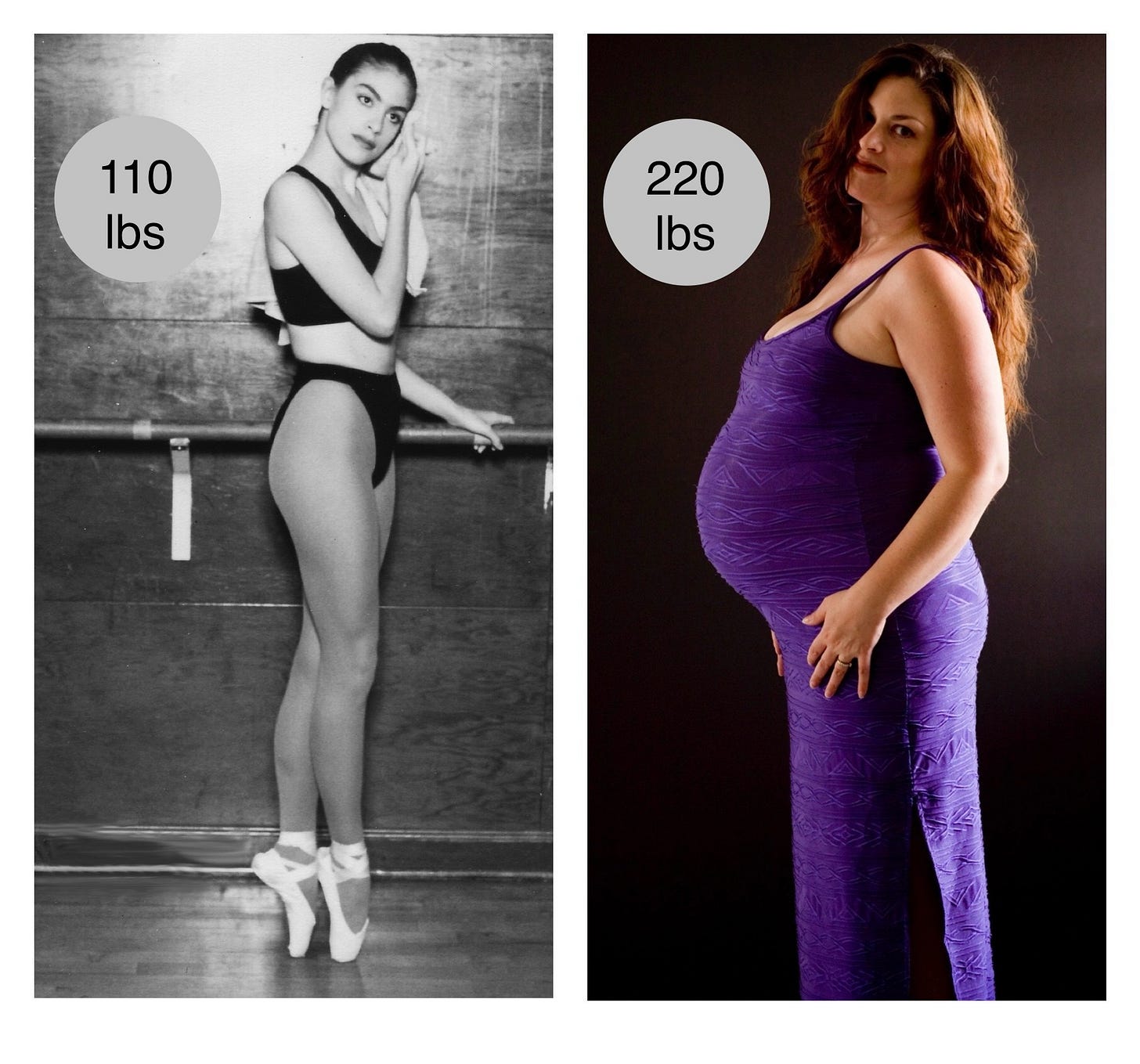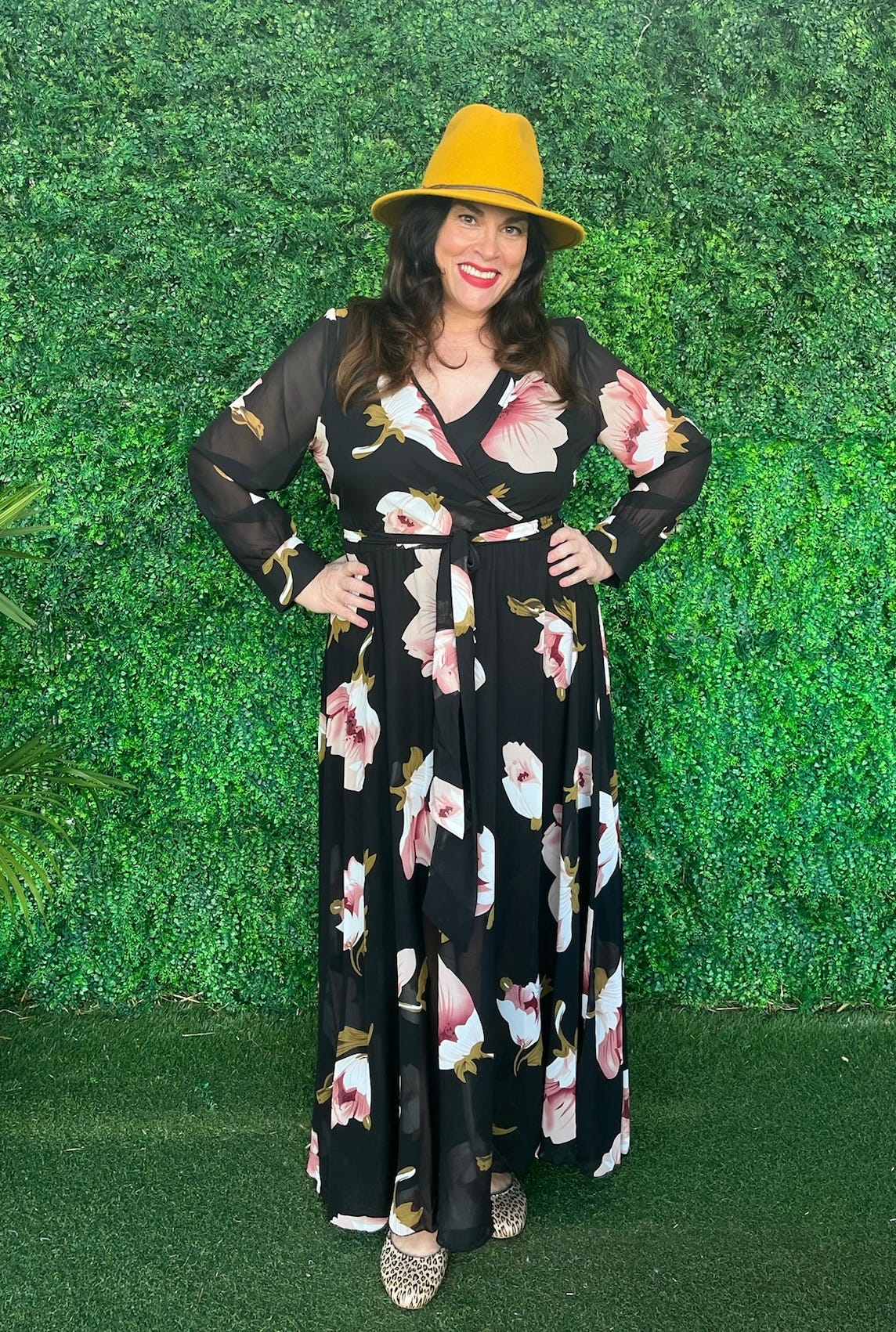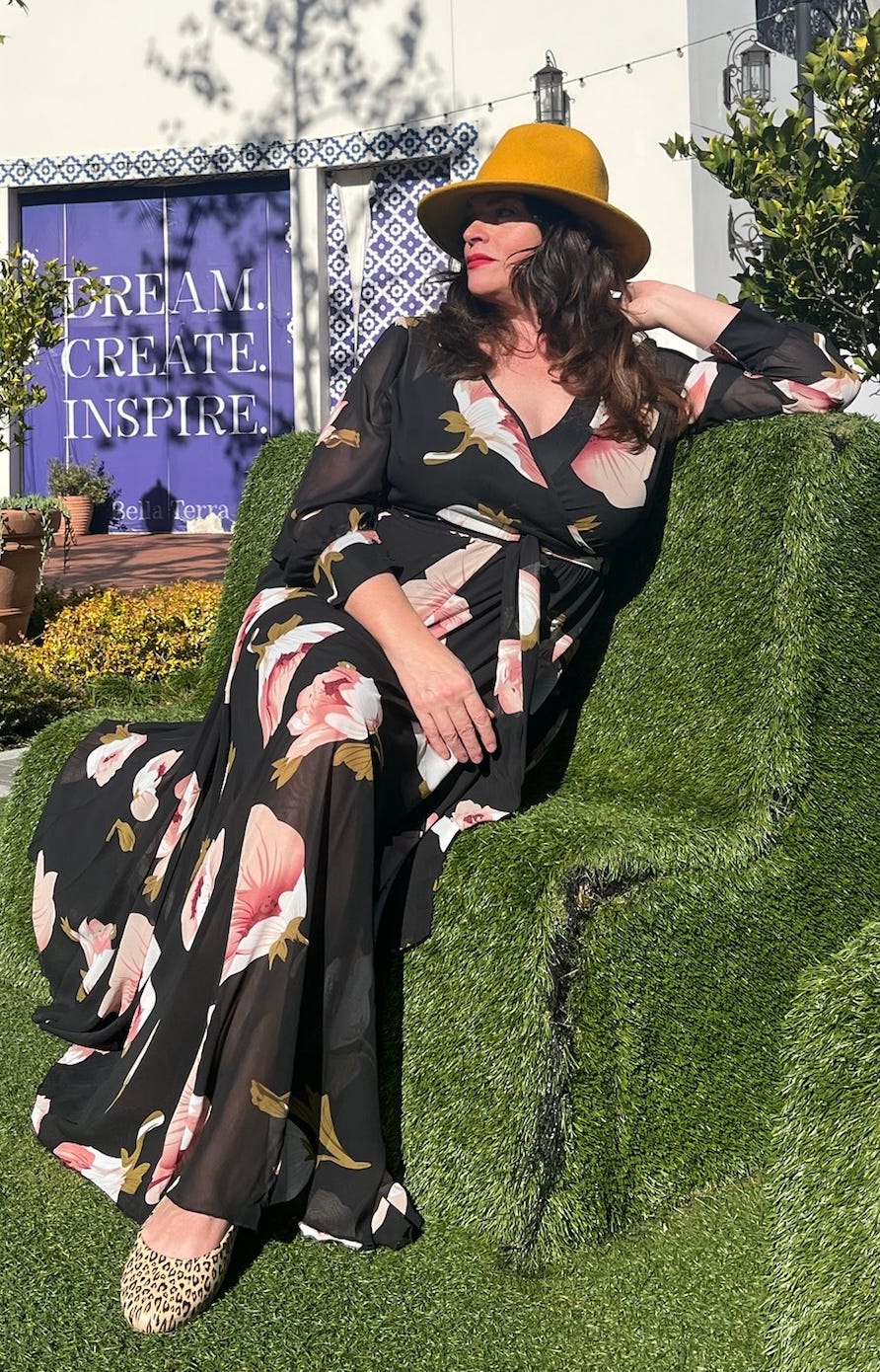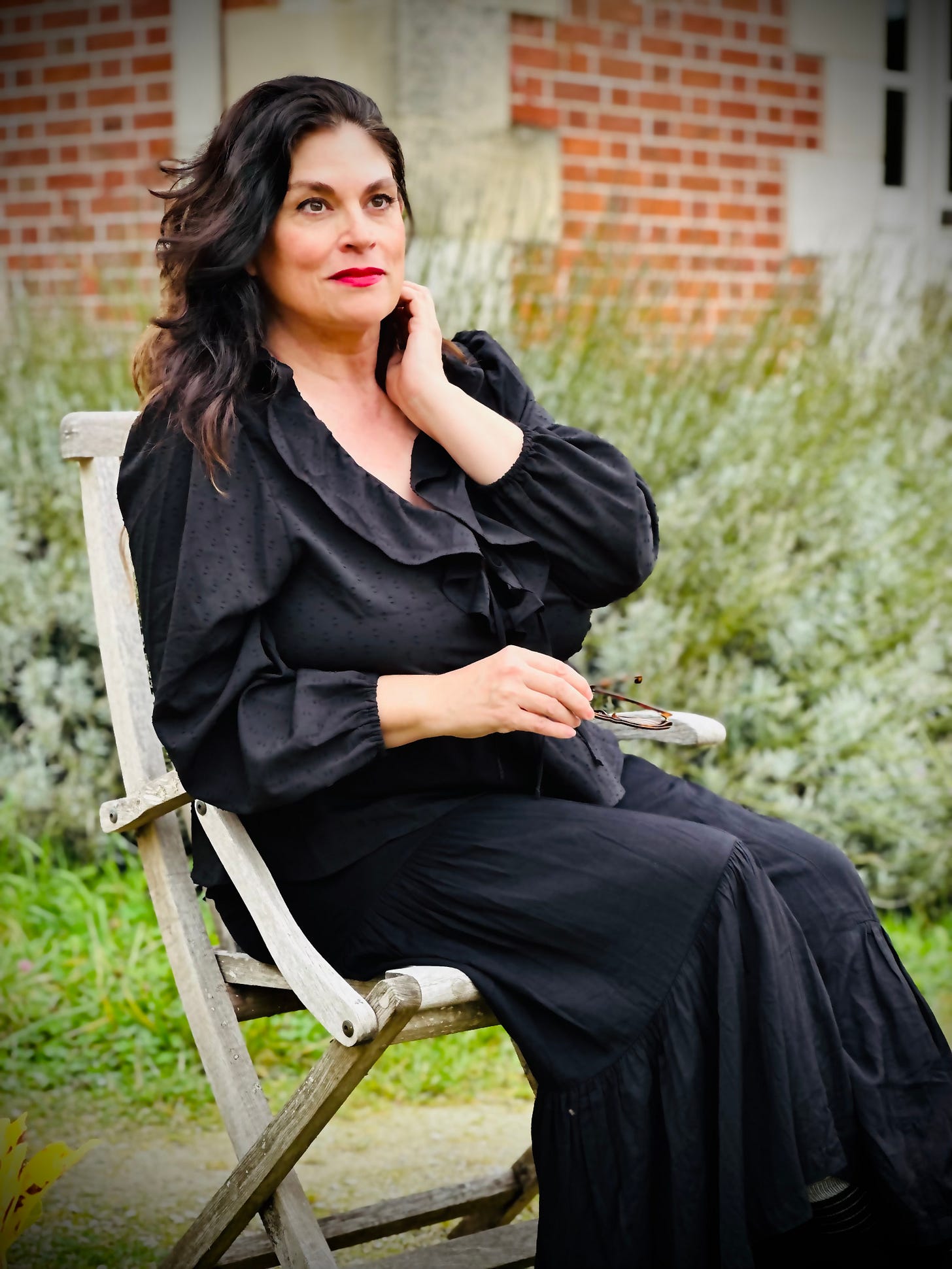Pregnancy Photo and purple body suit photo by Melinda Kelley @mkelleyphoto
As a young woman, I was an actor, model, and ballet dancer. At 110 pounds and a rough 5’8”, my BMI was about 17, which is technically underweight; and yet, in the entertainment industry, I was still considered “fat.” Thus began the realization that society measured my worth in pounds; and if I wanted to pursue my dreams, I would have to micromanage my weight to be seen as having value.
ENTERTAINMENT INDUSTRY WEIGHT STANDARDS
Tom Jennings was my theatrical agent at the time. He represented such stars as Gene Simmons from the band KISS, Burl Ives, Marion Ross, Lee Van Cleef, David Carradine, Cheryl Ladd, and many other creatives, including me as a hopeful ingénue.
After I left the ballet world, I gained enough weight that my BMI was 23, which while technically falls into “normal weight” was considered overweight in Hollywood. Tom Jennings promptly sent me to a place in the valley called The Diet Center, where they gave me diet pills and told me to eat chicken breast with every meal. I was a vegetarian and everyone around me was convinced I wasn’t eating enough protein. I ate the chicken to lose the weight, which is what I felt I had to do to keep my theatrical agent. I lost 15 pounds in two weeks—just in time for pilot season (and gained 20 back when pilot season was over).
I could fit a size 6, but I could actually breathe in a size 8.
I remember auditioning for the first round of the TV show FRIENDS, that just about all actresses in the 1990s were brought into, feeling so much bigger than those other women and thinking, “If the camera adds 10 lbs, I will have to be ‘underweight’ to look ‘normal weight’ on TV; and I don’t think I can sustain that indefinitely without becoming an addict of some sort.” Apparently, I wasn’t the only one who had these thoughts. I remember being on the set of a soap opera, which shall go unnamed, where on the craft services table (that’s where the food for the cast and crew is placed) there was a giant bowl of what looked like Dexitrim pills (popular diet pills of the time that contained ephedra, an amphetamine like compound linked to strokes).
I was a tall and athletic looking 135 lbs, which was the lowest weight ideal I believed I could attain while not killing myself in the process. I chased that weight for decades. Weighing anything over 135 lbs. felt like a failure to me, and I spent many years allowing Voltaire’s perfect to be the enemy of my “good enough.”
If I could go back to past me, I would hug her tight and tell her to go easy on herself. I’d encourage her to find a middle path between “ideal” and “giving up” and to redefine success as inner peace and contentment, versus fame and fortune. Even though I wasn’t pursuing fame and fortune as much as I was simply wanting to make a living at my craft as an artist, I knew the number on the scale carried far more weight, in Hollywood, than my talent.
CHASING SKINNY LED TO STAYING FAT
In the hourly struggle to maintain my weight, I became a vegan and tried every diet and exercise program that I could, including Dick Sutphan’s hypnosis tapes that I listened to each night. (Yes, I said “tapes” as in cassette tapes because that’s how old I am.) In my day job, I was even a certified nutritionist and personal trainer; and I started running charity 5k and 10k races and trained for a marathon. In the pursuit to remain a skinny size six, I became a curvy size 16; that which is chased, runs.
My body fought all the diet foods, caloric restrictions, and extreme exercise and created a set point of weight that seemed to be set in stone. My size wasn’t just fat, it was also a reflection of hormone fluctuations and increased muscle. Despite my weight being evenly distributed it was still noticeable to casting directors as weight gain. This was before plus sized women were allowed to be celebrated; being overweight was expected to come with card carrying, apologetic shame. I know a fair amount of fat-phobic, body-image-obsessed people, who have a preoccupation with weight (theirs and others), who share the space I orbit. As a result, I still feel too much judgment around the number on the scale to share my actual weight here; but it was a number that did, in fact, bring me shame.
Chronic dieting led to chronic heart issues, a metabolic disorder, and destructive psychological deprivation; and still, society, my career, and even my community let me know that all my value as a woman was tied to my physical appearance, which was largely based on my weight. I can’t tell you how many times I’ve heard these back-handed compliments, “You have such a pretty face; if only you could lose weight, you’d have so many more opportunities in life,” or conversely, “Your features are too exotic to be a convincing, chubby, character actor.” Oof! I couldn’t win for losing (or should I say, gaining).
FITTING IN WHILE STANDING OUT
I found my place in the art world by writing my own roles. I created dozens of characters to tell the stories we face as women, as humans, to transfer the attention from women as objects to women as subjects. If we don’t change the narrative that a woman’s value is her appearance, we will forever be held hostage to that role.
All character photos of Sage Justice as “janedoe” were taken by Melinda Kelley @mkelleyphoto
Inspired by Carol Burnett, Lily Tomlin, Whoopi Goldberg, and Tracey Ullman, I wrote, produced, and performed two solo plays: Simply Complicated Life (Los Angeles), an autobiographical celebration of the integrity, tenacity, and resilience of the individual spirit; and To Breed or Not to Breed (New York), in which I interviewed over 50 different women from around the globe, and portrayed each one, to delve into the social, political, and personal impact of reproductive freedom and motherhood. Here’s a five-minute clip featuring a few of those characters and their stories. I was born with a fierce sense of urgency and passion for enlightened evolution, equality, and human rights advocacy through education and artistic provocation. Yet, my pursued revolution, no matter how profound or sincere, is often drowned out by the loud and thumping club beats of social expectation to simply adhere to the number on the scale, show up, smile, and be “pretty.”
THE EXPANSION OF PREGNANCY
Photo by Melinda Kelley @mkelleyphoto
I loved my career in the entertainment industry; but the more my value was determined based on external factors, the more I gravitated toward internal factors to create a meaningful life. For years I had dreams where I was giving birth- I thought they were metaphorical. The baby in my dreams would whisper, “I am your daughter; and when you invite me, I will be born to you.” When the biological clock ticked its last tock, I had a child late in life, my beloved daughter (my metaphor became my reality). I relished my growing belly. It was the first time in my life that I was proud of my stomach. I wore bikinis and crop tops and fitted dresses and felt more comfortable in my body than I ever had. Despite having a complicated, “advanced maternal age,” high-risk pregnancy, I loved every minute. Being pregnant is like having the flu but being really happy about it.
Photo by Melinda Kelley @mkelleyphoto
Prior to pregnancy, I was terrified of weight gain, stretch marks, breast changes and the horror stories I heard from women who said, “You can never get your pre-pregnancy body back without surgical help,” not because I cared about those things from a place of vanity but because I had the message pounded into me that my career dreams were dependent on my physical appearance. I was in a state of glowing nirvana, creating and nurturing a growing life inside my womb and feeling the timeless, connected thread of humanity with every being who had ever been through this process before me. While outside my window, the woodpecker mentality of the entertainment industry continuously picked, poked, pecked, and prodded “How do you plan to lose your pregnancy weight after giving birth?”
I lost just about all my pregnancy weight within days after giving birth as most of it was due to too much amniotic fluid (a rare medical condition called polyhydramnious). My uterus nearly ruptured from having too much amniotic fluid and I had to have an emergency c-section more than a month before my daughter was due to be born. There’s over a 100-pound weight difference between my body at its lowest weight as a ballet dancer, and my body at its highest weight which occurred during the expansion of pregnancy. It boggles my mind to think during my pregnancy I could fit two of who I was at my lowest weight into the body I was during my highest weight. This could have created a spiral of shame within me, instead, it inspired an enlightened awakening.
Photo by Melinda Kelley @mkelleyphoto
Pregnancy killed the part of my ego that associated my worth with how my body looked—and instead created value out of what my body could do: GROW AND FEED A HUMAN! The body is a miraculous wonder. My level of respect for all women and all bodies changed with pregnancy; it was a multi-faceted gift that gave birth not only to my child, but also to me. Nevertheless, the monk who is only a monk on the mountaintop, still has the work of integration to accomplish when judged by the standards of the world. I could claim enlightenment all I wanted but I still had to figure out a way to function in a fat phobic world.
PREOCCUPATION WITH WEIGHT, EVEN WHEN DYING
In order to conceive, I had to have a series of three surgeries to clear out the ravages of endometriosis and polycystic ovary syndrome. It was then they discovered I had a rare bleeding disorder, that led to an extremely low ferritin level, a specific type of anemia, that left me chronically fatigued. I needed regular infusions, which ended up lasting 15 years in total. Halfway through the process, I was diagnosed with Vascular Ehlers-Danlos syndrome and a gang of comorbidity hoodlums to haunt and ravage chronic pain across my body; and I was told that I had a shortened life-expectancy. This rare disorder may actually only be “rare” because its rarely diagnosed, which is why I’m sharing this bit of extraneous detail, in case it helps another woman discover the cause of her health challenges.
Returning to the topic of weight, here I was, literally in the fight of my life, and yet still aware of how people judged my worth by my weight. Even with the threat of death nipping at my heels, the pursuit to be thinner, to weigh less, to wear a smaller clothing size, persisted. The truth is that people treat me better the thinner I am, particularly the people in my life who value thinness and are repulsed by people who are overweight; therefore, how can I ever not be preoccupied, to some extent, with how others perceive my weight?
OVERWEIGHT PEOPLE CAN BE SEEN AS INFERIOR
While I was involved in a chess community, I must have come across literature a dozen times that read, “Science says people determine your competence, intelligence, and salary based on your weight.” I was taking I.Q. tests for fun and being told that being overweight immediately lowered my I.Q. in the eyes of others and made people assume I was less intelligent. Add to that, I am disabled, with an occasional need to use a cane, walker, or wheelchair; and according to similar articles, people with disabilities are often also perceived to be “less desirable candidates” for jobs, for relationships, for fitting into a broken world. Society was determining my value to be “less than” based on the size of my body, which was being determined to be “greater than.”
CRACKING THE CODE
I was the same size as the average American woman, and yet average was now considered plus size. I call that “fat math.” The only women I knew who were able to maintain their weight were either naturally thin, which really was rare, or more commonly, had obsessive, compulsive, or excessive behaviors around their body image (exercise addicts, drug addicts, and those with eating disorders, plastic surgery, or gastric bypass). Everyone seemed to be on the latest dieting craze, whatever that was (keto, juicing, cabbage soup, ozempic, getting a parasite—ahhh, Hollywood).
I can’t recall knowing anyone who had a healthy relationship with food, exercise, and body image. To make matters worse, I hated cooking and had a medical condition that prohibited any exercise that increased my heart rate, so drive-thru, dashboard dining, and convenience foods were easy poisons hastening my demise. Despite all my education of nutrition and fitness, I never knew what to eat or how to move my body in a safe way that worked for me.
A multitude of diet gurus purport the benefits of oatmeal and brown rice, which may work for some, but large swathes of the population can have blood sugar spikes from oatmeal, and digestive issues from brown rice (science and statistical studies in the reading list below). There are no health foods that are healthy for everyone, for too many elements come into play from food allergies to genetics.
The only way to know what works and doesn’t work is through extensive and patient trial and error on an individual basis. I couldn’t figure out how to break the code and maintain my health and sanity in the process. Never giving up, I read endless books on diet and fitness. I plowed along with everyone else through Weight Watchers, Nutrisystem, GNC supplements, P90X, Tai Chi, yoga, and the like, gaining and losing the same 50+ lbs. over and over again, and maintaining a wardrobe spanning six clothing sizes.
Finally, in 2022, I cracked the code to sustained weight loss and maximum health, at least for me personally, primarily based on picking apart pieces from a dozen or so different books (listed at the end of this piece) and watching others who were maintaining success without obsessing over their weight to do so. It didn’t require any surgeries, diet center fees, gym memberships, special equipment or perscription medication. It’s the method I’ve been using for a few years now and it’s still working.
The short version of cracking the code is—long walks in the sunshine, combined with balancing blood sugar and electrolytes with intermittent fasting, while eating nutrient dense foods the majority of the time and everything else in moderation. The long version includes understanding the role hormones, stress, mineral deficiency, microbiome health, and sleep play in weight loss and weight maintenance.
THE MINDFULNESS OF MENOPAUSE
A few years after giving birth (I actually entered perimenopause a few years before getting pregnant), I began my long descent into full blown menopause (a 20-year journey); and that’s when I really learned self-compassion and to love and appreciate this skin bag made of water, bones, and too much heart. After my diagnosis, a defective connective tissue disorder, I had been prescribed over 30 daily medications for every part in the body, because connective tissue affects every part of the body. As is so often the case, the cure was worse than the disease; so I replaced each of those medications with a new lifestyle habit.
I gave up alcohol, most processed foods, and all people pleasing. I took up drinking water and pure electrolytes. I started walking in the sun every day, barefoot (grounding), and on the sand whenever possible, meditating, speaking my mind, setting boundaries, making amends or burning bridges as needed, reclaiming my time, resetting my circadian rhythms to better manage my sleep, and eating simple whole foods that didn’t take a lot of energy to prepare—like potatoes (a forbidden food on most diets), avocados, beets, pickles (and other healthy fermented foods), legumes, olives, seeds, tomatoes, berries, some greens like butter lettuce & parsley, some fruits like berries, apples & bananas, healthy vinegars & oils, rich dark chocolate, and plenty of spices. Nothing has a greater impact on my health than the immediate feedback I receive from food. It either fuels or depletes my energy banks.
Once I understood the nutritional properties of each, and more about my own hormonal cycles, I understood that every food choice was either poison or medicine to the body.
MONKEY SEE, MONKEY DO
I followed friends who were finding health after menopause and learned about the challenges of oxalate overload on a vegetarian/vegan diet and the long-term success experienced from intermittent fasting. I gave myself permission to give up labels, like “vegan” and “vegetarian,” and chose to eat what I wanted based on the nutrients my body was craving and what was available to me at the time (mostly Buddha bowls, Mediterranean plates, and tacos—some of my favorite foods). I quit dieting and depriving myself but embraced moderation. Eighty percent of the time, I chose foods based on the nutrient density and fuel they offered my body; and twenty percent of the time, I allowed myself to eat whatever I wanted.
IS THE SCALE FRIEND OR FOE?
I gave up the pursuit of ever weighing 135 lbs. again, without giving up on weighing myself daily to maintain my healthy weight once I achieved it. While I allow for the possibility that my body may still find its way to 135 lbs. naturally, by maintaining the weight loss method I’ve found that works best for me, it’s no longer something I am chasing. I did, however, discover that there is a number on the scale that seems to be the magic number to keep our blood pressure, cholesterol, liver enzymes, and blood sugar in check and that number is specific to each of us. Oprah, for example, has said that for her, weighing 200 lbs. is the tipping point where her health starts to turn downward (this was before she started using Ozempic—something I would never touch unless medically necessary). For other women my height, healthy may hover between 150-170 lbs. Paying attention to what the scale says, when we start to feel better or worse, is a helpful metric.
SHOULD WE TOSS THE SCALE?
Certain experts encourage women with a dieting history like mine to give up their scales. One of the many things I tried over the years was listening to that advice. Big mistake. Only using clothing to judge my weight instead was like trying to put out a fire once the house was up in flames. The scale allows us to smell the smoke before the flame, when the fire of weight gain is much easier to control. As my closet will reveal, managing my weight by how my clothing feels is just an invitation to buy new clothing with elastic waistbands. Nope. I will not be doing that again. As my grandmother used to say, “Keep your friends close and your enemies closer,” The scale has become my frenemy and I keep it very close. Mister Rogers said he weighed himself every day and it was part of what kept him on track. If it’s good enough for Mister Rogers, it’s good enough for me.
MANAGING THROUGH METRICS
I like metrics and know from experience that one lazy week of eating of Chinese food leftovers by day, and movie popcorn and candy by night, can equal a pound a day of weight gain, which is an entire clothing size for me. Therefore, I respect the scale and still weigh myself every morning, just as I floss my teeth each night—it’s all part of health hygiene. I track not only my daily weight, but also hours slept, miles walked, hours fasted, and any excess stress or consumption of my 20% foods (sugars, grains, processed foods, animal products, and bad oils). Logging my daily metrics (not calories) is part of the consistency that keeps my health on track—it shows me what’s working and what’s not in real time to help me avoid yo-yo dieting.
Tracking my weight no longer feels like a punishment I have to manage to be accepted, but rather it’s become an act of self-care to prioritize and monitor my health. When I’m at a healthy weight, I feel so much stronger and better mentally, physically, and emotionally that I want to nurture and maintain that feeling. Nevertheless, I do realize that for those who suffer with eating disorders, or disordered eating, this may increase their obsession and should therefore be avoided. There is rarely one right way that serves us all. We discover what works, most often, by first experiencing what doesn’t work.
OVERWEIGHT AND HEALTHY
Photo by Gracie Justice @Gracie_Justice2024
This picture was taken of me in November 2023, wearing a coat over three layers of clothing; and just having even the slightest bit of a waistline visible with all those layers makes me feel healthy (less of an apple shape, less risk of cardiovascular disease). Looking at my legs and knowing all they have carried me through in life with strength and flexibility, fills me with gratitude. I finally feel like who I am, at the size I am, is acceptable to me, and depending on where I am, to most (but even a 10 pound weight gain can put me into a category of social scorn).
I still have weight loss goals I’d like to maintain, but they are far more reasonable and attainable than weighing 135 pounds has proven to be. My BMI is still in the “overweight” range; but I don’t care about that anymore, as long as my blood work comes back better (which it has every six months since I’ve been intermittent fasting the past few years), and I can enjoy any food I want (in moderation), fit into my favorite clothes, and feel cute in pictures.
I’m OK being “overweight” if I feel healthy and content in my body and lifestyle. Despite my medical diagnosis and pain levels, in many respects I feel healthier and better than I have in years. Self-acceptance also plays a major role in our health and happiness.
I share this to inspire all the women (and men) who feel, or have felt, the same struggles. I’m not so naïve to think that our health, happiness, attractiveness, or perceived value is NOT tied to the size of our bodies; but neither am I convinced that it is.
We all have a set point where we feel our best, not just in how we look in clothing but in how free we are to enjoy food, one of life’s many communal and sensual pleasures. Health is found in balance, and balance looks different for each of us. My measure of success is no longer obtaining and maintaining an unreasonable, unattainable number on the scale—but rather, an awareness of how obtaining and maintaining a reasonable, attainable number on the scale makes my life easier.
Photo by Gracie Justice @Gracie_Justice2024
HOW DO WE DEFINE SUCCESS?
I define success as creating the freedom of time, living authentically in my integrity with the courage to rock the boat if necessary to speak the truth.
I define success as having the energy and mobility to walk every day, to maintain healthy relationships that allow me to boundlessly love and be loved unconditionally whilst still maintaining boundaries that keep me aligned with my purpose.
I define success by the contentment I possess in having a career that allows me to express creatively, the ability to choose slow living and prepare nutrient rich meals with whole foods, the bliss I experience with my family and friends when being playful, and the joy of not cringing when I see a photo of myself but rather feeling a loving motherly affection and response of, “Hello my darling. You look beautiful. I am so proud of who you are and have become. I love you more than you will ever know. Keep shining.”
We could all use a little more tenderness in our self-talk and a lot less criticism. Loving ourselves unconditionally plays a crucial role in our success in every area of life.
I was able to achieve my definition of success by giving up the ideal size six (there was no size zero when my ideal was being indoctrinated) and accepting and appreciating being a healthy size 12-16, depending on life’s fluctuating circumstances.
Photo by Gracie Justice @Gracie_Justice2024
This picture was taken of me in January 2024, it’s a picture of a relaxed woman who, after half a century on this planet, is finally comfortable in her own skin. Our bodies are meant to change to accommodate all we carry in life, from children, to burdens, to good will and heart-centered blessings. We must change the narrative that our value is in the size of our body. Stop pressuring women to keep the same body from puberty to old age— to “get back” to where they were before they changed. Just as we do not try to get the butterfly to become the caterpillar again, we must allow and celebrate women and their changing bodies through every stage of life. 🦋
The more judgments I release, from myself and others, the lighter I feel. The more toxic and dysfunctional relationships I let go of, the less I literally weigh. Sometimes we learn to carry fat as a shield to protect our vulnerabilities; boundaries allow us to shed that fat and still remain safe. The more I love myself, the stronger my boundaries and the more lovingly I treat myself. Chronic dieting, like chronic exposure to dysfunctional circumstances, is a form of self-abuse. I will not abuse myself in any way, ever again, no matter the prize. Now, I love myself the way I love my child. I’ve learned to parent myself into health and wellbeing. We are more than the object of a body; we are the subject of a body of work-in-progress.
I’m a woman who, through deep respect and tender daily care, has made peace with my changing body … of work.
WEIGHT LOSS BOOKS
These are but some of the weight loss books I used to find a method that works for me and a few documentaries, as well.
1. “What to Eat When” by Dr. Crupain and Dr. Michael Roizen, 2018
2. “Get Up!” by James A. Levine
3. “Sitting Kills, Moving Heals” by Joan Vernikos
4. “The Plant Paradox” by Dr. Steven Gundry, 2017
5. “The Personalized Diet” by Segel & Elinav, 2017
6. “The China study: The Most Comprehensive Study of Nutrition Ever Conducted and the Startling Implications for Diet, Weight Loss and Long-term Health” by T. Colin Campbell and his son, Thomas M. Campbell II. 2005.
7. “The Healthiest Diet on the Planet: Why the Foods You Love-Pizza, Pancakes, Potatoes, Pasta, and More-Are the Solution to Preventing Disease and Looking and Feeling Your Best” by Dr. John McDougall and Mary McDougall
8. “The Second Brain” by Michael Gershon MD, 2019
9. “Neurofitness: A Brain Surgeon’s Secrets to Boost Performance and Unleashed Creativity” by Rahul Jandial, MD, PhD., 2019
10. “Sugars and Flours: How They Make Us Crazy, Sick, and Fat” by Dr. Joan Ifland
11. “The Pleasure Trap” by Dr. Doug Lisle and Dr. Alan Goldhamer
12. “Unprocessed” by Chef AJ
13. “Glucose Goddess” by Jessie Inchauspé
14. “Fast Like a Girl” by Dr. Mindy Pelz
15. “Lifespan: Why We Age — and Why We Don’t Have To” by David Sinclair, 2019
Documentaries
• From vegan (The Game Changers, 2018) to paleo (Food as Medicine, 2016), it’s a privilege to have the luxury of a diet based on food preference alone.
Description for the visually impaired-Photo of Sage Justice, wearing poet’s black, holding eye glasses with her right hand, while her left hand puts her long, chocolate brown, waves of hair behind her left ear, as she looks off pensively in the distance at a church whose bells are ringing, soulfully. Sage sits in a wooden folding chair, outdoors, in front of a red brick stone castle near a patch of fragrant lavender, in France, at the Writers and Artists-in-Residence at Chateau d’Orquevaux.
Sage Justice is an award-winning poet, author, critically acclaimed performing artist, and intensely sincere, bold humanitarian activist.
If you appreciate this publication, Sage Words, but are unable to afford a subscription, please consider choosing the “Buy Me a Coffee” button when you can. Every little bit helps. Thanks!
Read the book FREEDOM ⭐️⭐️⭐️⭐️⭐️

